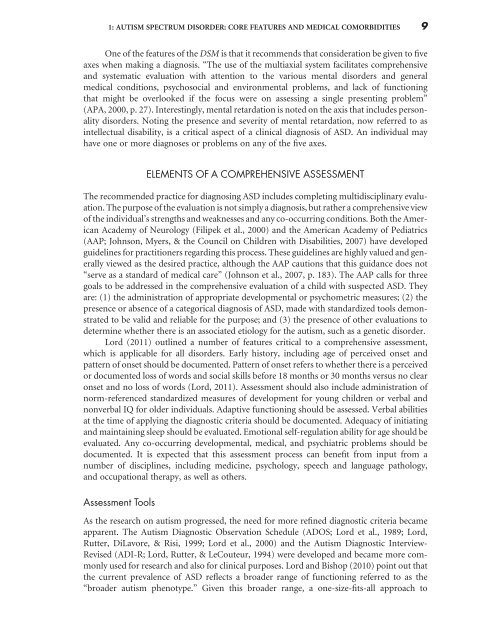Nursing of Autism Spectrum Disorder - Springer Publishing
Nursing of Autism Spectrum Disorder - Springer Publishing
Nursing of Autism Spectrum Disorder - Springer Publishing
You also want an ePaper? Increase the reach of your titles
YUMPU automatically turns print PDFs into web optimized ePapers that Google loves.
1: AUTISM SPECTRUM DISORDER: CORE FEATURES AND MEDICAL COMORBIDITIES 9<br />
One <strong>of</strong> the features <strong>of</strong> the DSM is that it recommends that consideration be given to five<br />
axes when making a diagnosis. “The use <strong>of</strong> the multiaxial system facilitates comprehensive<br />
and systematic evaluation with attention to the various mental disorders and general<br />
medical conditions, psychosocial and environmental problems, and lack <strong>of</strong> functioning<br />
that might be overlooked if the focus were on assessing a single presenting problem”<br />
(APA, 2000, p. 27). Interestingly, mental retardation is noted on the axis that includes personality<br />
disorders. Noting the presence and severity <strong>of</strong> mental retardation, now referred to as<br />
intellectual disability, is a critical aspect <strong>of</strong> a clinical diagnosis <strong>of</strong> ASD. An individual may<br />
have one or more diagnoses or problems on any <strong>of</strong> the five axes.<br />
ELEMENTS OF A COMPREHENSIVE ASSESSMENT<br />
The recommended practice for diagnosing ASD includes completing multidisciplinary evaluation.<br />
The purpose <strong>of</strong> the evaluation is not simply a diagnosis, but rather a comprehensive view<br />
<strong>of</strong> the individual’s strengths and weaknesses and any co-occurring conditions. Both the American<br />
Academy <strong>of</strong> Neurology (Filipek et al., 2000) and the American Academy <strong>of</strong> Pediatrics<br />
(AAP; Johnson, Myers, & the Council on Children with Disabilities, 2007) have developed<br />
guidelines for practitioners regarding this process. These guidelines are highly valued and generally<br />
viewed as the desired practice, although the AAP cautions that this guidance does not<br />
“serve as a standard <strong>of</strong> medical care” (Johnson et al., 2007, p. 183). The AAP calls for three<br />
goals to be addressed in the comprehensive evaluation <strong>of</strong> a child with suspected ASD. They<br />
are: (1) the administration <strong>of</strong> appropriate developmental or psychometric measures; (2) the<br />
presence or absence <strong>of</strong> a categorical diagnosis <strong>of</strong> ASD, made with standardized tools demonstrated<br />
to be valid and reliable for the purpose; and (3) the presence <strong>of</strong> other evaluations to<br />
determine whether there is an associated etiology for the autism, such as a genetic disorder.<br />
Lord (2011) outlined a number <strong>of</strong> features critical to a comprehensive assessment,<br />
which is applicable for all disorders. Early history, including age <strong>of</strong> perceived onset and<br />
pattern <strong>of</strong> onset should be documented. Pattern <strong>of</strong> onset refers to whether there is a perceived<br />
or documented loss <strong>of</strong> words and social skills before 18 months or 30 months versus no clear<br />
onset and no loss <strong>of</strong> words (Lord, 2011). Assessment should also include administration <strong>of</strong><br />
norm-referenced standardized measures <strong>of</strong> development for young children or verbal and<br />
nonverbal IQ for older individuals. Adaptive functioning should be assessed. Verbal abilities<br />
at the time <strong>of</strong> applying the diagnostic criteria should be documented. Adequacy <strong>of</strong> initiating<br />
and maintaining sleep should be evaluated. Emotional self-regulation ability for age should be<br />
evaluated. Any co-occurring developmental, medical, and psychiatric problems should be<br />
documented. It is expected that this assessment process can benefit from input from a<br />
number <strong>of</strong> disciplines, including medicine, psychology, speech and language pathology,<br />
and occupational therapy, as well as others.<br />
Assessment Tools<br />
As the research on autism progressed, the need for more refined diagnostic criteria became<br />
apparent. The <strong>Autism</strong> Diagnostic Observation Schedule (ADOS; Lord et al., 1989; Lord,<br />
Rutter, DiLavore, & Risi, 1999; Lord et al., 2000) and the <strong>Autism</strong> Diagnostic Interview-<br />
Revised (ADI-R; Lord, Rutter, & LeCouteur, 1994) were developed and became more commonly<br />
used for research and also for clinical purposes. Lord and Bishop (2010) point out that<br />
the current prevalence <strong>of</strong> ASD reflects a broader range <strong>of</strong> functioning referred to as the<br />
“broader autism phenotype.” Given this broader range, a one-size-fits-all approach to

















